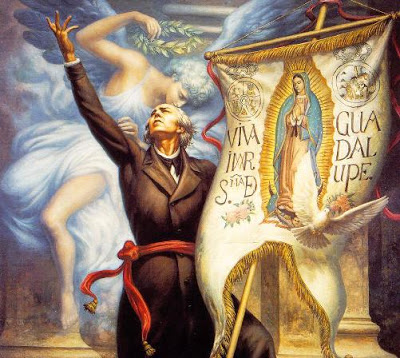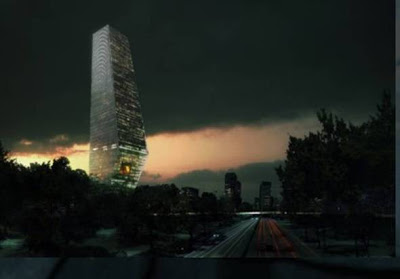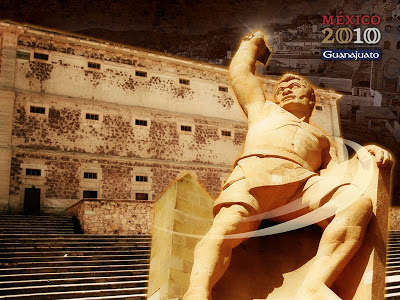Can a new revolution be far behind?
The countdown to Mexico’s Buy-Centennial
‘Viva Mexico! Let’s go kill some Gachupines!’
By John Ross / The Rag Blog / September 8, 2010
MEXICO CITY — The clocks are literally ticking as Mexico starts the final leg of the countdown to the 200th anniversary of its independence from Spain. Dozens of huge, solar-powered timepieces have been installed in this monster city’s great Zocalo plaza and 31 state capitols to mark the minutes until the Bicentennial celebration kicks in this September 15th-16th.
At 2.8 million pesos each, the price of the clocks is a mere drop in the bucket compared to what President Felipe Calderon is lavishing on the actual festivities.
Mexico has budgeted 3 billion pesos for the nation’s birthday fete but costs will surely exceed that modest allocation. In a country where 70% of the population lives in and around the poverty line, 50% of Mexican families cannot afford the basic food basket, and 13 million children go to bed without supper each night, Bicentennial bread and circuses will not staunch the hunger that stalks the land
How much of this multi-billion peso boodle will be pilfered, embezzled, subcontracted out to dubious friends of the house, or otherwise flushed down the drain, remains to be calculated.
Mexico is one of eight Latin American republics that will celebrate the 200th anniversary of their separation from a debilitated Spain back in 1810 this year — but it is the only country on the continent that will also commemorate the centennial of a landmark revolution that toppled an entrenched oligarchy.
The numerical coincidences between the catastrophic conflict that began in 1810 (500,000 were dead before the war of liberation was concluded in 1821) and the revolution of 1910 (a million killed) have given rise to the thesis that every hundred years, on the tenth year of the century, this distant neighbor nation explodes in lethal social upheaval.
In Mexico 2010, with an economy in free fall, unemployment at record levels, and 28,000 citizens slaughtered in Calderon’s uncalled-for war on the drug cartels, this timetable for renewed revolution is not an unlikely projection.
But aside from revolutionary numerology, there is an historical connection that explains the reoccurrence of social rebellion here in 1810 and 1910. 1910 was an election year and the dictator Porfirio Diaz, who had governed the country with an iron fist for 34 years, stealing election after election, was determined to maintain power despite his increasing unpopularity. Clapping his chief rival, the liberal Francisco Madero, in jail weeks before the balloting, the 83 year-old Don Porfirio once again crowned himself top dog — like Diaz, current president Felipe Calderon is often accused of having stolen the 2006 election.
Then as now in 2010, deep recession was on the land and Porfirio Diaz quashed social discontent by calling out the army to restore order (Calderon has 50,000 troops in the field.) Faced with disintegrating governability, the dictator moved to soothe the restive masses by throwing a big party to celebrate the Centennial of the nation’s independence.
Monuments and statues were erected throughout the capitol, most prominently the gilded Angel of Independence that still rises above the Paseo de La Reforma, the city’s most traveled thoroughfare. Indeed, the dictator invested millions in refurbishing the avenue and transforming it into a sort of Mexican Champs D’Elysie.
Borrowing a page from Don Porfi’s playbook, Calderon last spring laid the cornerstone for a multi-million-peso “Bicentennial Tower of Light” at the foot of Reforma Boulevard. Cost overruns on the monument have already doubled and the Tower will not be open for business until late 2011, if ever, due to engineering snafus.
A hundred years ago, among other Centennial projects, Porfirio Diaz cut the ribbon at the site of a new headquarters for the Congress of the country but two months later, revolution washed over the land and the dome-like structure was left unfinished — after the conclusion of hostilities, the dome was converted into the Monument of the Revolution.
Similarly, Calderon’s list of Bicentennial projects includes new quarters for the Mexican Senate — weeks before the big fiesta that building too remains unfinished.
One hundred years ago, commemorative events and glittering banquets and balls filled the dictator’s days and nights. Showers of fireworks lit up the skies. New pants were distributed to the poor although they were discouraged from attending the festivities. As is standard operating procedure in this ultra-centralized nation, the fiesta was confined to the capitol and the provincials uninvited, further ratcheting up tensions between the countryside and the big city.
When word got out that the dictator had spent Mexico’s entire social budget on the Centennial of Independence — there was no money left over to even pay the wages of teachers — all hell broke lose. On November 20th, 1910 the Mexican revolution erupted and Diaz was overthrown.
Felipe Calderon has been faithful to Don Porfi’s scenario. Aside from the Bicentennial Arch and the new Senate chambers, he has inaugurated a multi-billion peso extravaganza, the “Expo Bicentenario,” in Guanajuato (see sidebar below); streets and schools all over the country have been renamed for the “Heroes who gave us a Fatherland,” and a Bicentennial park in the north of Mexico City, constructed on the site of an abandoned refinery that befouled the air of this megalopolis for decades, is open for business. Toxicity levels are said to be still so high that just sitting on the grass can be dangerous to one’s health.
Calderon’s management of the Bicentennial has been haphazard. Five coordinators, starting with Cuauhtemoc Cardenas, the son of a beloved president, have signed on and then abruptly quit in the past six years, most recently when Juan Manuel Villalpando, a right-wing historian, turned over the reigns of the operation to Secretary of Public Education Alfonso Lujambio, often cited as Calderon’s successor in 2012.
With less than a month until the big birthday party, public buildings like the National Palace, the Palace of Bellas Artes, and the Supreme Court are being scrubbed down for the event. Miles of red, white, and green bunting — the colors of the Mexican flag — are being draped over downtown skyscrapers such as the 84-story Torre Mayor, the tallest building in the nation.
The Bicentennial cultural calendar is packed. A magnum exposition of patriotic icons, including the polished skull of Padre Miguel Hidalgo y Costilla, the profligate priest who first gave voice to the struggle for independence, and the mixed bones of either 12 or 14 other martyrs (it has not yet been determined whose bones are whose) will be displayed in the National Palace which the citizenry is cordially encouraged to visit (the Palace is usually locked down and sealed by the military.)
Other commemorative offerings include the publication of a reedited official edition of The History of Mexico issued by Lujambio’s Public Education Secretariat. The volume has been heavily critiqued by academics because Calderon and his PAN party have imposed a right-wing spin on the nation’s biography. Much of the revised text appears to be the work of the discredited Enrique Krauze, house historian for Televisa, the senior partner in Mexico’s two-headed television monopoly and a bosom buddy of Juan Manual Villalpando.
The volume tilts towards a conservative interpretation of historical events and tends to gloss over darker moments in the national narrative –there is no mention of slavery and yet a third of the population at liberation was Afro-Mexican. The sugarcoated treatment of Antonio Lopez y Santana, an arch-villain who ceded half of Mexico’s national territory to Washington, is remarkable. The 1968 massacre of 300 striking students by the Mexican military is described as “a large demonstration that was repressed” with no attribution as to the repressors.
In a recent Proceso magazine interview, historian Victor Diaz Archiniaba disses the revised “History of Mexico” as a history of the country’s politicos and not its people. The right-wing PAN, posits the popular Autonomous Metropolitan University professor, is uncomfortable with lionizing personages such as Hidalgo, his successor Jose Maria Morelos, and revolutionary apostles Emiliano Zapata and Francisco Villa who defied the Catholic Church, rose up against repressive regimes, and overthrew conservative governments.
The Calderon government’s plans for the twin centennials have favored the 200th anniversary of Independence over the 100th year Centennial of the Mexican Revolution, an uprising of the poor with which the PANistas have never been sympathetic.
Capitalism has bought up the franchise for the “Buy Centennial” — as some unpatriotic wags have dubbed the upcoming festivities. As every year during September, “the patriotic month,” vendors push handcarts through the city streets laden with “tricolor” flags, plastic “coronetas“- a sort of Mexican vuvuzela whose braying bleats add to the urban din — and tons of patriotic tchotchkes. To honor the Bicentennial, the mugs of Padre Hidalgo and his coconspirators invite consumers to buy tee shirts, kids clothes, cigarette lighters, milk cartons, and cans of beans, phone cards, and lottery tickets.
A cartoon version of the struggle for independence, True Heroes, is about to roll. Creator Carlos Kuri concedes his film is a “lite” version of Mexico’s oft-violent history. Hidalgo, Morelos et al more resemble “Batman, Spiderman, and Indiana Jones” than their original role models, he says — Morelos’s voiceover was dubbed by “Brozo,” the green-haired “scary clown” AKA Victor Trujillo, a Televisa warhorse. True Heroes action figures are being heavily marketed.
Other Buy Centennial specials include a Bicentennial lottery (“Bicentenario“), a Bicentennial bike race (“Bicenton“), a time capsule to be opened a hundred years hence if in fact Mexico survives until then, the issuance of various postage stamps, a youth parliament, a racquetball championship, an international regatta, and an NBA exhibition game between the San Antonio Spurs and the Los Angeles Clippers.
Although the list of international dignitaries who are invited to the Bicentennial hijinks is closely held, the buzz is that Spain’s Prince Felipe and his princesa Dona Leticia will be on hand when Calderon pronounces the immortal “Grito de Independencia” from the presidential balcony overlooking the Zocalo on September 15th. Given the presence of the royals, the “Grito,” as first sounded by Father Hidalgo — “Viva Mexico! Let’s Go Kill Some Gachupines” (Spaniards) — will have to be modified for the occasion.
Calderon’s September 15th “Grito” will be preceded and followed by multiple military parades — foreign contingents, including one from the United States whose troops have invaded Mexico five times, will pad out the processions. Nearly half the Mexican army is currently in the field waging the President’s bloody drug war.
To top off the fiesta, the heavens over Mexico City will be illuminated by world-class pyrotechnics organized by Australian Ric Burch whose SpecTak Productions staged the opening pageant at the Beijing Olympics. Burch, who will be paid a million Yanqui dollars for the fireworks display, has promised to learn Spanish for the Bicentennial.
September 15th, traditionally “La Noche Mexicana” when the natives don floppy sombreros, tank up on rotgut tequila, yowl nostalgic mariachi tunes, and shoot off their pistolas like “real Mexicanos,” is always a blast but this year should be a lollapalooza. In 2008, purported narcos tossed a bomb into a crowd celebrating “La Noche Mexicana” in Morelia, Michoacan, killing eight party-goers and tens of thousands of Mexico City and federal police will be assigned to the Zocalo to keep the crowds from killing each other.
After an all-night fandango, Calderon will be helicoptered to Dolores Guanajuato where Miguel Hidalgo y Costilla, a survivor of a failed conspiracy to overthrow the Spanish rulers, uttered the original “Grito,” the one about killing the Gachupines.
As legend has it, once the good padre had bellowed his murderous oath, he strode across the town plaza and threw open the doors of the local jailhouse. Hundreds of Indians and Afro-Mexicans who had been forced to slave in the silver mines (Mexico produced a third of the world’s currency in 1810) surged out, picked up machetes and torches, and marched on the nearby silver capitol of Guanajuato City where they rounded up the white elites in the grain house or Alhondiga and set it ablaze.
The fire is said to have been ignited by a disaffected miner whose nickname “El Pipila” now graces taco stands and other purveyors of roasting meats throughout Mexico.
On the morning of September 16th to conclude Bicentennial activities in Guanajuato, Felipe Calderon will host a gala breakfast for local elites at the Alhondiga, a structure from which the captured Padre Hidalgo’s head once swung.
Given the repression, economic devastation, hunger, corruption, and violence that blankets the land in this centennial year, many Mexicans are wondering if, much as in Porfirio Diaz’s day, a new revolution can be far behind?
[John Ross, author of El Monstruo: Dread and Redemption in Mexico City, is currently in San Francisco for medical treatment.]
Guanajuato:
The rotting cradle of Mexican independenceLargely because of Hidalgo’s revolutionary caper, the state of Guanajuato has been designated “the Cradle of Independence” and to celebrate the Bicentennial, this past July 17th President Calderon cut the ribbon at a hundred acre theme park, “Expo Bicentenario” near the agricultural nexus of Silao and facing Cubilete (Cupcake) Hill to whose “Christ the King!” shrine, the state’s Catholic zealots make an annual pilgrimage.
The Bicentennial Expo includes a pavilion dedicated to the heroic Mexican military, an institution that is currently under international fire for human rights violations, and a Hall of History featuring a life-sized caveman and cave woman, and even a baby mammoth specially flown in from Russia.
A virtual Hidalgo will declaim a virtual “Grito” and a virtual Pancho Villa will sit in a real train car and tell the story of the Mexican revolution. A monumental Guinness Book of Records Mexican flag flies over the pavilions and a 40 million-peso figure of “Winged Victory,” Calderon’s version of Porfirio Diaz’s “Angel of Independence,” stands guard over the theme park.
Also on the bill: a light show, carnival rides, and kiddie cars. Pop music stars like Cheyenne, Yuri, and the hoary Ballet Folklorico de Mexico have been booked in for nightly shows.
The Expo Bicentenario is the largest public works project ever built in the state of Guanajuato. Although Coca Cola will pick up part of the tab, the state government has kicked in 800,000,000 pesos which, much as in Don Porfirio’s day, will certainly diminish social budgets.
Guanajuato, which has been under the PAN’s thumb for a generation, is one of the most privatized states in the Mexican union — even the Mummies of Guanajuato, the mummified bodies of miners and their families and a venerable tourist attraction, are now owned by the private sector. The mummies are being transported to Mexico City as part of Calderon’s September fandango.
Guanajuato is an unlikely venue to celebrate this country’s struggle for liberty. Police repression in the state is horrific — nine prisoners have died in police custody in the last 14 months, including a farmer whose beating death was recorded by video cameras. A private U.S. security firm was hired last year to teach the industrial city of Leon’s security forces torture techniques.
Hunger is endemic in Guanajuato, particularly among the state’s 40,000 indigenous residents, as graphically demonstrated by the looting of grain boxcars in the city of Celaya earlier this year. The state has one of the highest out-migration exoduses to the United States in Mexico.
The PAN’s ferocious clampdown on public morals is often humiliatingly painful. Kissing in public is a punishable offense in Guanajuato city, which was once renowned for its famed “Callejon del Beso” or Kissing Alley. Last year, a civic group in Leon burnt public school sex education text books on a pyre in the city square because they contained anatomical diagrams of reproductive organs, and Luz Maria Ramirez Villalpando, director of the Guanajuato Women’s Institute, does power point presentations stigmatizing as deviants women with tattoos and piercings because they “cheapen moral values.”
Abortion, even for rape and incest victims, has long been outlawed in Guanajuato with women receiving up to 35-year sentences for simply soliciting an interruption to unwanted pregnancies. Six women are currently imprisoned in state penitentiaries for purportedly murdering their children in the womb — Governor Juan Manuel Oliva who labels pro-choice groups as “terrorists,” insists that he has proof that all of the women gave birth and then killed their offspring, a fact vehemently rejected by local feminists.
“What are we supposed to celebrate when Guanajuato, the cradle of national emancipation, forces girls that have been raped to be mothers, access to therapeutic abortions is denied, and women are jailed for seeking to end unwanted pregnancies?” feminist Georgina Altuna recently wrote in the left daily La Jornada.
Such is the state of constitutional liberties in the place that gave birth to Mexico’s Independence as the Buy Centennial gets underway.
— J.R.





















If I actually believed that prayer did anything more than reduce the “creator” to a cosmic bellhop I would pray that some day Mexico might celebrate its independence from the United States TREASURY.
Well, I dont know from where you get the fact that there are 70 percent of mexicans living in poverty. The CEPAL says it is only 35 percent. Come on, Mexico is a middle income country, with a high HDI = .854 and a medium GDP per capita at USD14,500
Hey, moron, as for your comment about the GDP falling into a “middle category,” you have to understand that is an average. And when you have the world’s richest man, Carlos Slim making such a huge amount it throws things into perspective. I live here and see the poverty, and it’s all due to the failed capitalistic policies of the past. THE OLIGARCHY BE DAMNED!
Who are these rubes?
Ross wrote some interesting stuff plus a lot of stereotypical Berkeley hippie bunk. Mexico it an outstanding place exhibiting multiple fine qualities due, in large part, to the enterprising nature of Mexicans.
Alexander Nalle